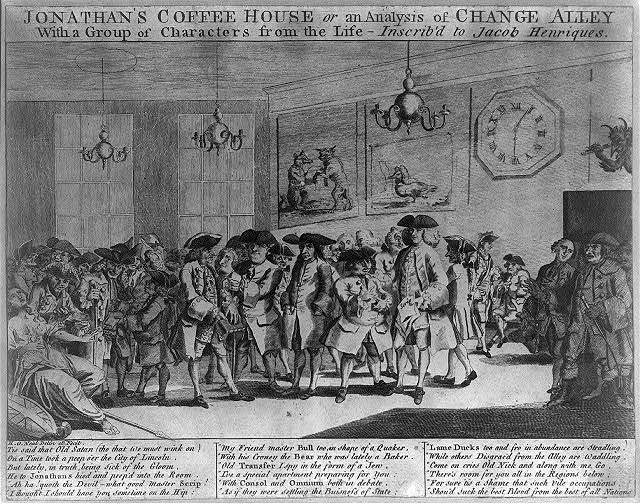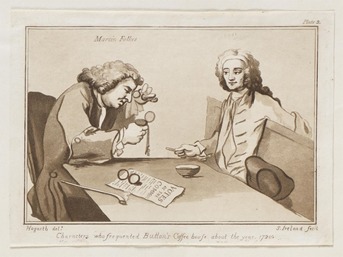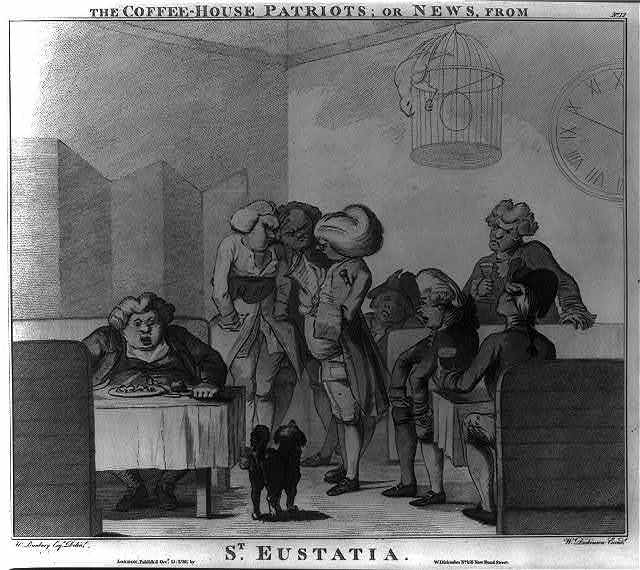The Rise of the Coffeehouse
This image is a painting created by an unknown British artist in the year 1763. The painting represents a depiction of the British coffeehouse at its cultural apex. The interior of the coffeehouse is busy and men are seen talking and socializing in a grand open space with seated areas surrounding it. There is a noticeable lack of women in the image as all characters portrayed are males. By looking at the image, one can get a sense of the etiquette and decorum of the era. The idea of a sophisticated sense of style is showcased by the clothes the characters are wearing, which are elegant in style as well as the decorations of the room. Large, elaborate paintings adorn the wall as well as an expensive looking clock. Multiple chandeliers hang down from above. Large glass windows are shown which would have allowed light to pour through the space, illuminating the area that was seen to be metaphorically enlightened with knowledge and class. The elegance of the coffeehouse is on full display in this image.
This image, created by a British printmaker, is a depiction of a British coffeehouse in the year 1720 by creator Samuel Ireland. It highlights an idealized archetype of the coffee drinker – wealthy, elite and intellectual. The characters are seen wearing expensive clothing and smoking pipes. One man is using his eyeglasses to inspect a pocket watch. These are markers of a luxurious, affluent lifestyle. The headline of the newspaper on the table reads “Votes of the Common.” The introduction of coffeehouses to England spurred greater political discourse, and this image reinforces the idea that coffeehouses were seen to be more civilized places for people to gather to discuss political news and information. Despite the pressure to look sophisticated and elite, coffeehouses allowed people from all walks of life to gather. The coffeehouses themselves encouraged people to stay and chat through their designs which often featured warm fires and comfortable furniture. For the small price, it was no wonder wives were complaining outspokenly about their husbands' gone missing spending hours away in the coffeehouse. “For very little financial outlay he could spend hours sitting by the fire, read the newsletters of the day, meet friends and conduct business, and engage in discussion on everything from politics to shipping to the latest scientific inventions” (Waller, 196). Newspapers of the day such as The London Gazette and Flying Post found permanent homes and large audiences in coffeehouses. These represented a huge part of British society. The Swiss foreigner César de Saussure, commenting on this aspect of British culture, said that "What attracts enormously in these coffee-houses are the gazettes and other public papers. All Englishmen are great newsmongers. Workmen habitually begin the day by going to coffee-rooms in order to read the latest news" (Chrystal). The consumption and discussion of the news obtained from newspapers allowed for a culture of civility and debate unique to coffehouses as a public forum on hot political issues available for both the very wealthy and commoners. “Coffee drinking ultimately came to be seen as associated with sober and civil conduct and as such, it became a key part of an ethic of “respectable” behavior shared by both the middling and elite classes” (Cowan 2004, 32). The unwritten code of conduct seen in coffeehouses allowed them to develop their identity as a place of civility in a bustling London city which lacked it in comparison.
This image depicts the interior of a coffeehouse from 1781 – the source says it is most likely from London. The print shows men in the commerce business who are reading an open newspaper. They seem alarmed as they hear about news of the capture of a British port that was frequented by merchants conducting illegal trade. The fact that they are reacting negatively together is an example in displaying how coffeehouses brought people together to talk about the news. The stimulating effects of coffee aided in people’s ability to stay alert and this sobriety was in stark contrast to the negative effects of alcohol that preceded it. The men are all dressed in clothing that only members of the middle or upper classes would be able to afford. In the image, there is an obese man which is another symbol of wealth as it showcases the lavish lifestyles of the elites who did attend the coffeehouses. There is also a dog, which further demonstrates this idea. The man in the far right is drinking from a glass rather than a cup. There is a birdcage hanging from the ceiling and a clock on the wall. This was by no means a place for the impoverished to dine. The visual imagery added to the aura of knowledge created by the inhabitants. One author describes this tendency, "While the coffeehouse is rightly associated primarily with print and scribal publications because it was an increasingly important venue for the reading and distribution of such materials, the coffeehouses were also important sites for the display of visual images" which often included "pictures hanging on framed walls" as well as "cheaper prints such as broadsides and woodcuts" (Cowan 2005, 87). The imagery helped entrench the coffeehouse as a place of knowledge and class.



